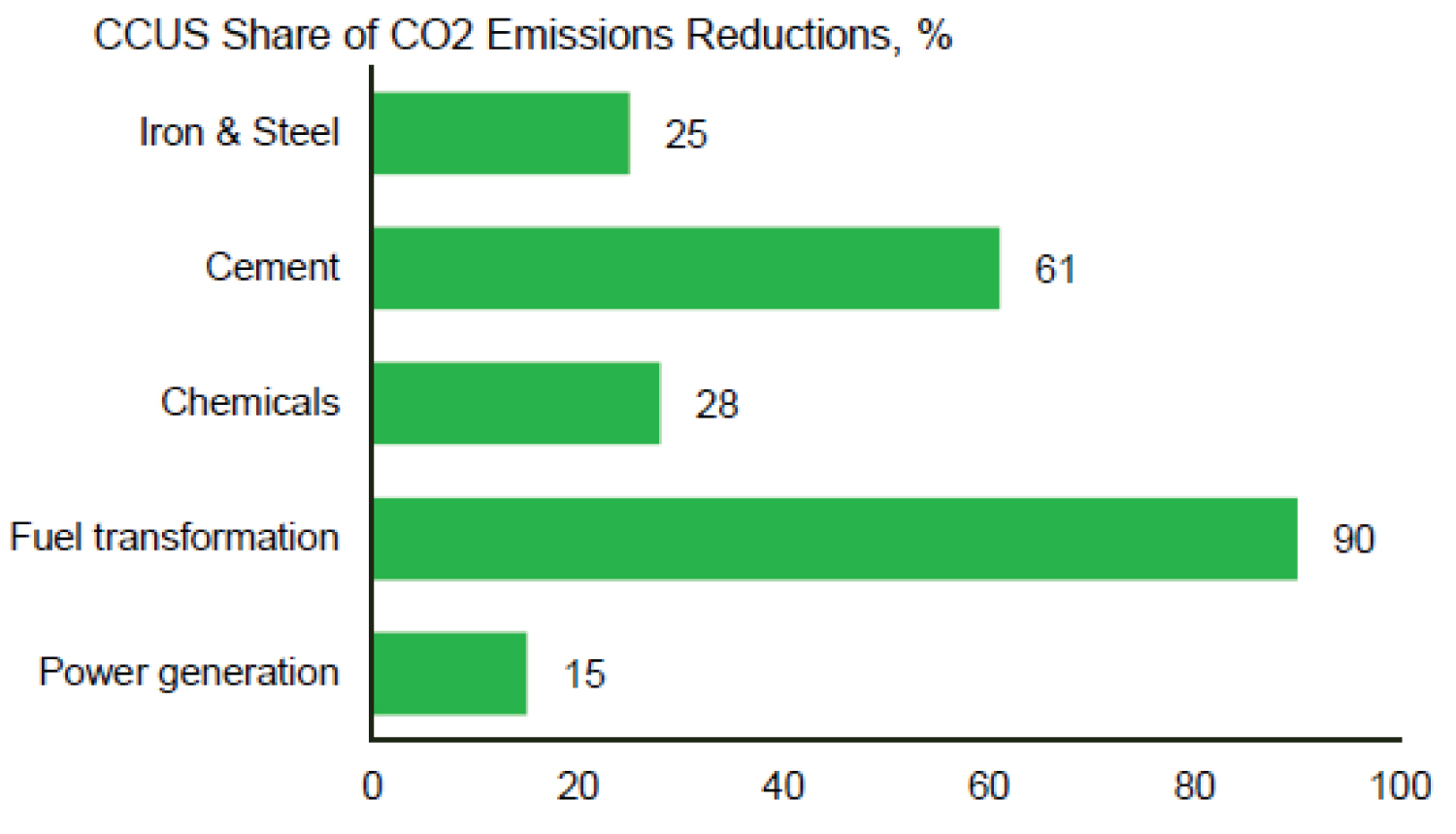The Critical Necessity for CCUS
Carbon Capture, Utilization and Sequestration (CCUS) encompasses a suite of technologies that remove CO2 from the atmosphere, predominantly by sequestering it underground. The importance of CCUS has been recognized globally since early applications began in the late 1970s and the 1980s as a critical solution to meeting greenhouse gas (GHG) reduction goals. Capturing CO2 is only a small part of the process. It also requires processing, transporting, and permitting and storage or utilization of the CO2 -- primarily for enhanced oil recovery.
CCUS is a contentious issue. Some renewable energy (RE) advocates contend that the shift to net zero CO2 emissions is possible exclusively with RE, without investing in either continued fossil fuel production or CCUS. They contend that this pathway eliminates concerns about the viability of CCUS and that investments in CCUS will divert needed capital from RE technologies. They also argue that CCUS implies continued use of fossil fuels and reliance on fossil fuel byproducts and delays the transition away from fossil fuels. They thus contend that investing in CCUS technologies would prolong the world's reliance on fossil fuels and detract from efforts to pivot to renewable alternatives.
However, these objections ignore several salient considerations:
• As discussed below, achievement of ambitious climate goals is impossible without massive CCUS - beginning immediately.
• Affordable, dispatchable electricity generation from fossil fuels will be required indefinitely.
• Fossil fuel byproducts will always be required as feedstocks for the production of thousands of products including pharmaceuticals, plastics, clothing, computers, ink, paint, asphalt, cosmetics, I-phones, tires, eyeglasses and contact lenses, candies, dentures, etc. • Technical and economic problems are not unique to CCUS; they afflict RE technologies as well.
• CCUS is the only feasible option for decarbonizing hard-to-abate sectors such as fertilizers, aluminum, steel, cement, petrochemicals, etc. For cement production, CCUS is the one currently available technology for meaningful emissions reductions. CCUS has the potential to account for 15%-90% of emissions reductions in the iron and steel, cement, chemicals, fuel transformation, and power generation sectors - Figure 1.
CCUS can be viewed as an insurance policy. First, for the foreseeable future there will still be many industries and processes for which decarbonization is not viable. For these, CCUS represents a line of defense to ensure there is a way to capture CO2 emissions. Second, the U.S. is at present dangerously dependent on China for many of the critical materials required for RE technologies. CCUS is insurance against this overreliance and for energy reliability and security.
CCUS technology will also play a role in the clean energy transition broader than just capturing emissions in fossil fuel production and heavy industries. Critical components of most net zero scenarios require production of bioenergy, clean fuels, and CO2 removal technologies. CCUS technology and infrastructure enhances their viability.
CCUS is an especially important part of the clean energy transition where hydrogen becomes a dominant energy source for application in the transportation, industry, and building sectors. Collectively, these sectors produce nearly 60% of total global energy-related CO2 emissions.
IEA has determined that reaching net zero will be impossible without massive CCUS and that it must form a key pillar of global net-zero emissions strategies. IEA found that CCUS is essential:
• CCUS reduces emissions from existing energy infrastructure and can be retrofitted to existing power and industrial plants that would otherwise emit 600 billion tons of CO2 over the next five decades -- 17 years' worth of current annual emissions.
• CCUS is a solution for some of the most challenging emissions -- heavy industries account for 20% of global CO2 emissions, and CCUS is the only technology for large emissions reductions from many of them.
• Captured CO2 is a critical part of the supply chain for synthetic fuels from CO2 and hydrogen and is one of few low-carbon options for long-distance transportation, particularly aviation.
• CCUS can support a rapid scaling up of low-carbon hydrogen production to meet current and future demand from new applications in transportation, industry, and buildings.
• For emissions that cannot be avoided or reduced directly, CCUS is an important technological approach for removing CO2 and creating a net-zero energy system.
In the IEA Sustainable Development Scenario, where global CO2 emissions from the energy sector decline to zero by 2070, CCUS accounts for nearly 15% of the cumulative emissions reduction. The CCUS contribution increases over time and includes most of the global energy system. IEA estimates that $160 billion must be invested in CCUS by 2030, a ten-fold increase from the previous decade, and that the amount of CO2 captured must increase 20-fold by 2030 -- to 800 million tons from 40 million tons currently. IEA head Fatih Birol stated "Without CCUS, our energy and climate goals will become virtually impossible to reach."
CCUS offers a significant opportunity for the U.S. in terms of both economics and CO2 reduction. CCUS will:
• Permit clean, sustainable economic growth.
• Expand international market and trade opportunities.
• Address emissions from the toughest-to-abate but crucial sectors of the economy.
• Enable other essential decarbonization pathways (e.g. electrification, hydrogen) to deliver CO2 removal via CCUS.
CCUS is thus a technology whose time has come:
• It is a proven CO2 reduction technology.
• The UN Commission for Europe concluded that ambitious CO2 reduction goals are not feasible without massive CCUS initiatives: "If the world is to succeed in constraining CO2 emissions to levels consistent with a less than 2 °C rise in global temperatures, then CCUS needs to contribute 1/6th of required CO2 emission reductions in 2050, and 14% of cumulative emissions reductions though 2050."
• The IPCC stated "All analyzed pathways limiting warming to 1.5 °C require CCUS to neutralize emissions from sources for which no mitigation measures have been identified and also to achieve net negative emissions to return global warming to 1.5 °C following a peak."
• CCUS enjoys strong bipartisan support in state legislatures and the U.S. Congress.
• Advocates of the Green New Deal acknowledge the necessity for CCUS as a large part of the program. When Representative Alexandria Ocasio-Cortez (D-NY) and Senator Ed Markey (D-MA) introduced a resolution for a Green New Deal, they included CCUS.
• Even environmentalists endorse CCUS. For example, the National Wildlife Federation stated that "CCUS is one of the tools in our climate solutions toolbox we need to use if we want to reduce emissions on an urgent but realistic timeline to protect people and wildlife."
• CCUS is a program that will likely continue to enjoy broad support for many years to come.
However, the U.S. and the world are behind schedule on decarbonization, and are falling further behind every year. If it is to meet its commitments, the U.S. must drastically accelerate CCUS deployment and commercialization.
Fortunately, in the USA the recently enacted IRA 2022 contains enhanced tax incentives for accelerating CCUS. The Investment Tax Credit (ITC) was extended through 2024, along with new credits for CCUS. In 2025, these credits change to emissions-based, technology-neutral tax credits available to any net zero power generation, which is crucial for fossil fuels if they can deploy CCUS. Power producers have the flexibility to use either the ITC, the Production Tax Credit (PTC), or sell credits to third parties. Previously, a tax investor buying a credit was required to have an ownership interest in the facility receiving the credit. Now, these credits can be sold directly to anyone with tax liabilities. This represents a workaround to a direct payment option -- where operators receive cash in lieu of a tax credit. Power operators now have more options to maximize their facilities' economic potential. These tax credits will remain in place until 2032 or when the U.S. achieves a 75% reduction in CO2 emissions from 2022 levels, at which point they would phase out over several years. This long-term stability removes one of the largest biggest risk factors for CCUS.
Large-scale U.S. CCUS projects must be rapidly implemented and expanded. Notably, it is critical that the planned CCUS retrofit of the San Juan Generating Station (SJGS) in New Mexico be implemented. Public Service of New Mexico plans to close the SJGS, while the City of Farmington, NM, and Enchant Energy propose to retrofit SJGS with CCUS and keep it open. Farmington and Enchant plan to retrofit the plant with post-combustion CCUS technology that will reduce CO2 emissions by up to 90%. Post-CCUS, SJGS will have CO2 emissions reduced to 247 lbs/MWh - becoming Low Emissions Electricity (LEE). LEE produces 70% less CO2 emissions than a new combined-cycle gas turbine and 80% less emissions than a gas peaking plant. The project will provide $1.3 billion in private investment, financed through the monetization and forward sale of IRS Section 45Q tax credits.
In conclusion, CCUS will need to form a key pillar of efforts to put the USA and the world on the path to net-zero emissions. A net-zero energy system requires a profound transformation in how we produce and use energy that can only be achieved with a broad suite of technologies. Alongside electrification, hydrogen, and sustainable bioenergy, CCUS will need to play a major role. It is the only group of technologies that contributes both to reducing emissions in key sectors directly and to removing CO2 to balance emissions that cannot be avoided - a critical part of "net" zero goals.
Thus, if the U.S. is to achieve its decarbonization goals, it is critical that the SJGS CCUS retrofit - and many others like it - be deployed as soon as possible.
About the Author
Dr. Bezdek has over 30 years' experience in the energy, utility, environmental, and regulatory areas, serving in private industry, academia, and the Federal government, and is the founder and president of MISI - a Washington, D.C.-based economic, energy, and environmental research firm. His background includes energy R&D, technology, and markets; oil, coal, natural gas, hydrogen, renewable, hydro, and nuclear energy analyses; assessment of DOE energy programs; estimation of the costs and benefits of energy systems; economic analyses of environmental and energy technologies; energy forecasting; and creation, funding, and management of Federal government and private industry energy programs.
Corresponding Author
Roger H. Bezdek, Management Information Services, Inc., 2716 Colt Run Road, Oakton, VA 22124, USA
Copyright
© 2023 Bezdek RH. This is an open-access article distributed under the terms of the Creative Commons Attribution License, which permits unrestricted use, distribution, and reproduction in any medium, provided the original author and source are credited.





